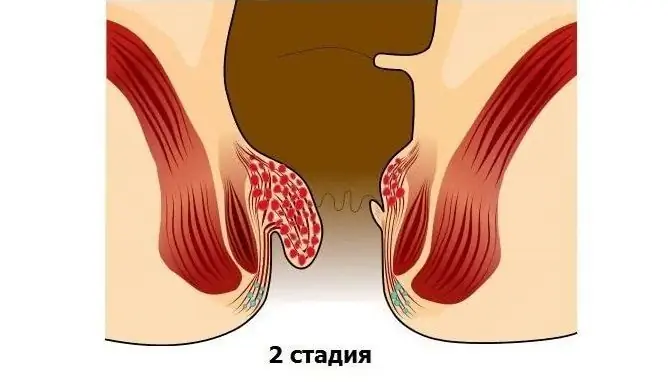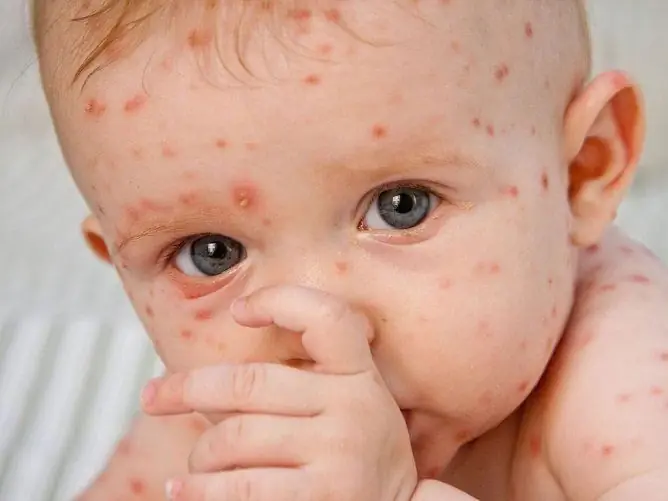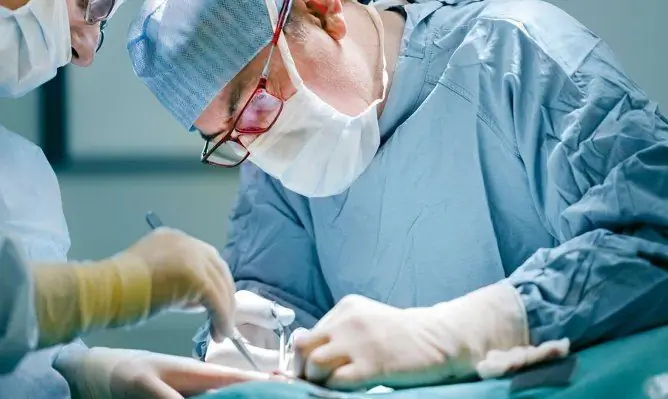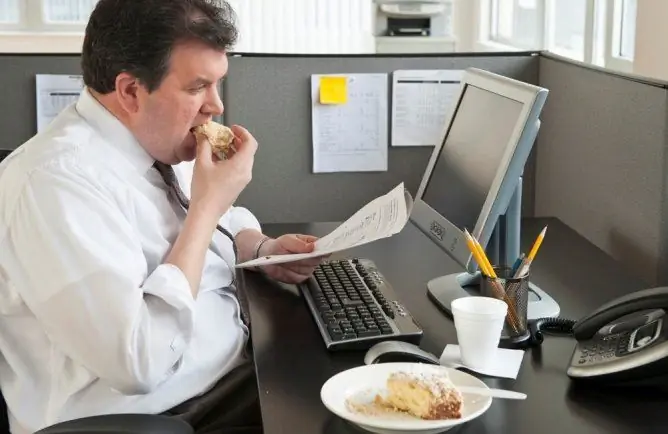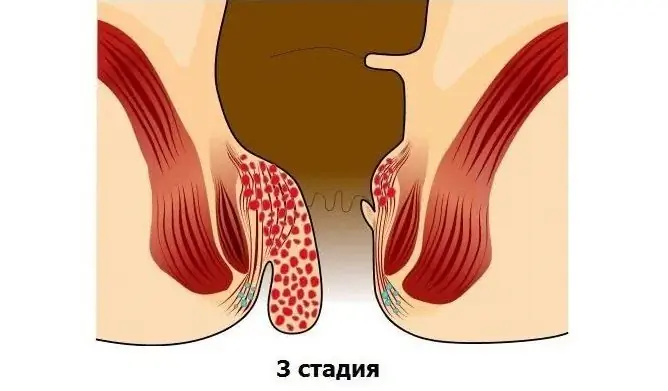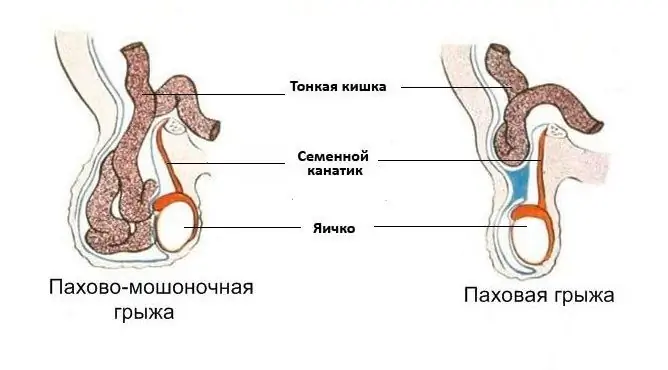- Author Rachel Wainwright [email protected].
- Public 2023-12-15 07:39.
- Last modified 2025-11-02 20:14.
Hemorrhoids 2 degrees: treatment, symptoms
The content of the article:
- Hemorrhoids 2 degrees - what to do?
- Symptoms of the second stage of hemorrhoids
- Stage 2 hemorrhoid treatment
- Lifestyle correction and diet therapy
- How to treat hemorrhoids with folk methods
- Video
Hemorrhoids of the 2nd degree are often diagnosed at the first visit to the proctologist, since this period is characterized by severe clinical manifestations. Hemorrhoids are a widespread proctological disease, in which there is a pathological expansion of the vessels of the lower part of the anal canal with the formation of hemorrhoids, which, as the disease progresses, increase, periodically inflame and bleed.

At this stage, hemorrhoids can be treated with conservative remedies.
At the second stage of the disease, dystrophic processes continue in the musculo-ligamentous apparatus, however, the elastic muscle fibers of the rectum are still preserved. With a sharp increase in intra-abdominal pressure (excessive straining during bowel movements, intense physical activity, lifting weights), internal hemorrhoids may fall out of the anal canal. However, due to the preservation of the elasticity of the fibromuscular frame, they are adjusted into the rectum on their own. The walls of the mucous membrane of internal hemorrhoids gradually become thinner and easily injured, which leads to bleeding from the nodes.
Hemorrhoids 2 degrees - what to do?
If you suspect the presence of hemorrhoids, it is recommended to immediately visit a doctor, undergo an examination and start treatment. At this stage, treatment is usually limited to conservative methods without surgery; hemorrhoids can be eliminated by conducting therapy at home. The risk of complications and adverse consequences during this period is relatively low.
Since excessive physical activity is contraindicated in hemorrhoids, in some cases, in the presence of this disease, a decision may be made to postpone the draft.
Symptoms of the second stage of hemorrhoids
Hemorrhoids can be acute, but more often they are primarily chronic. Depending on the localization of hemorrhoids, it is internal (the nodes are located in the rectum) and external (the nodes are located outside around the anus), as well as mixed, or combined (both external and internal nodes are present at the same time).
The appearance of the external nodes resembles a swelling around the anus; in the photo, stage 2 hemorrhoids look like bumps located in the perianal region, the same color as the surrounding skin. Internal hemorrhoids do not externally manifest themselves before the nodes fall out; the only visible sign of it is bleeding after bowel movement, usually insignificant, manifested by scarlet blood spots on toilet paper or blood in the feces. The prolapse of hemorrhoids at this stage also usually occurs during bowel movements. Bleeding usually stops on its own, the knots that have fallen out also set themselves up.
Discomfort in the anal area, itching, burning, feeling of constant presence of a foreign body in the rectum appears or increases. Sometimes the patient complains of a feeling of incomplete bowel movement after a bowel movement.
Since bowel movements are often painful, the patient may delay defecation, which, in turn, contributes to additional irritation of the rectal mucosa, thickening of stool and aggravation of symptoms.
Stage 2 hemorrhoid treatment
Despite the fact that the treatment of hemorrhoids at this stage can be carried out at home, a doctor should prescribe it and monitor the course of therapy. Incorrectly selected drugs, insufficiently active and consistent treatment, as well as its absence, lead to an aggravation of pathology, an increase in symptoms and an increased risk of complications.

Internal hemorrhoids in the second stage may not manifest themselves in anything other than minor rectal bleeding
The main method of treatment for grade 2 hemorrhoids in the acute stage is drug therapy. As a rule, local preparations are used, if necessary, drugs of general action are prescribed. With external hemorrhoids, medicinal ointments, creams, baths, lotions are mainly used, with internal hemorrhoids - rectal suppositories, microclysters, as well as ointments administered orally with an applicator.
Medicines are selected depending on the existing symptoms and disorders. With severe pain syndrome, local preparations are prescribed containing an anesthetic and an anti-inflammatory agent (for example, Proctosan), with a risk of thrombosis - anticoagulants (Nigepan), with bleeding - hemostatics (Relief, Natalsid).
A good therapeutic effect is provided by sitz baths with herbs or a weak solution of potassium permanganate. In case of exacerbation and bleeding, cool (not cold!) Baths are recommended, in the healing stage - warm ones.
As a rule, at this stage of the disease, 2-3 weeks of therapy are enough for remission to occur.
In the absence of a positive effect from drug therapy, it may be necessary to remove hemorrhoids, which is performed using minimally invasive methods:
- ligation of hemorrhoids with latex rings - the knot is pinched by a hypoallergenic rubber ring, blood circulation in it is impaired, it gradually dies off, then it is brought out during bowel movements;
- cryodestruction - blood circulation in the node stops after its treatment with liquid nitrogen;
- sclerotherapy - a sclerosing drug is injected into the hemorrhoidal node, which leads to gluing of the walls of the vessel that forms it, the cessation of blood supply in it and the death of the node;
- photocoagulation - hemorrhoids are exposed to infrared radiation of a certain spectrum, as a result of which the tissues forming them die.
Important in the treatment of hemorrhoids is the exact implementation of all the prescriptions and advice of the doctor.
Lifestyle correction and diet therapy
Effective treatment of grade 2 hemorrhoids is impossible without lifestyle changes leading to the development of the disease. In this case, only a temporary effect from the course of drug therapy is provided, and relapses are inevitable. Patients suffering from hemorrhoids need to adhere to a special diet, compensate for venous stasis during sedentary work with therapeutic exercises (Kegel exercises), proper organization of the workplace, walking, increased physical activity. At the same time, it is necessary to avoid physical overload, refuse to lift weights, and increase stress resistance. You should stop smoking and alcohol abuse, as well as, if necessary, normalize body weight.
Excessively fatty and spicy foods, baked goods and confectionery should be excluded from the diet, in the acute stage - any alcohol. It is recommended to eat more vegetables and fruits, flaxseed, seaweed, whole grain cereals, fermented milk products, bran. The goal of the diet is a complete, balanced diet that ensures regular bowel function. An abundant drinking regime is shown, at least 1.5 liters of water should be drunk per day.
How to treat hemorrhoids with folk methods
The main therapy can be supplemented with traditional medicine methods. Decoctions and infusions of medicinal herbs are used, which have a wound healing, anti-inflammatory, antiseptic effect. They are added to sitz baths, lotions and compresses are made with them, as well as ice candles. At home, you can prepare a medicinal ointment based on medicinal plants, propolis, natural oils with wound healing effects (sea buckthorn, rosehip, apricot).
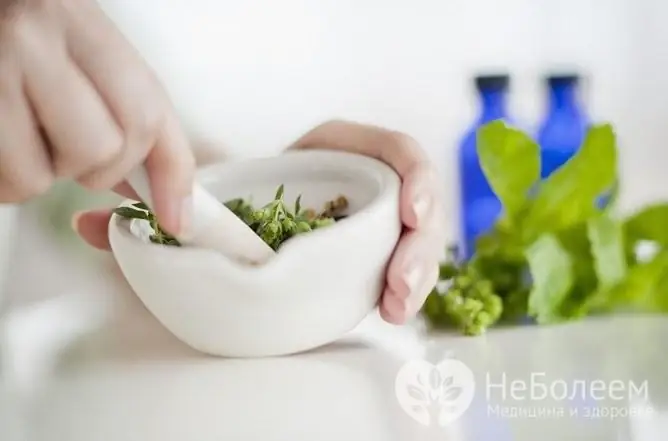
Traditional methods of treating hemorrhoids can be effective, but they should only be used with the approval of the attending physician.
It should be borne in mind that not all folk remedies are effective and safe. For example, you cannot use cucumbers for the treatment of hemorrhoids, especially directly from the garden - they can easily injure the inflamed mucous membrane and infect the infection. It is not recommended to use fresh onions and garlic, which are highly irritating.
The use of traditional medicine should be carried out under medical supervision in the same way as drug treatment.
Video
We offer for viewing a video on the topic of the article.

Anna Aksenova Medical journalist About the author
Education: 2004-2007 "First Kiev Medical College" specialty "Laboratory Diagnostics".
Found a mistake in the text? Select it and press Ctrl + Enter.

